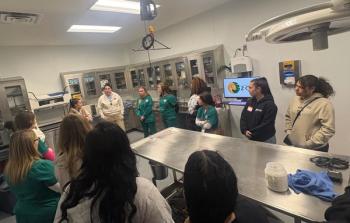
Open the door to senior care at your veterinary clinic
Those soft, white muzzles and wise eyes beg for your attention and compassion. Use these easy adaptations to offer a gentle veterinary experience to aging pets.
Elderly patients are a large part of every general or specialty practice, and keeping these slightly slower (and slightly wiser?) patients comfortable during their visit allows a more stress-free examination for both team members and patients. There are many small adjustments you can make in any hospital to help geriatric patients' visits flow more smoothly. It's also helpful to offer different diagnostic packages for your hospital's elderly pets.
We all love seeing kittens and puppies at their first few visits. But it can be even more rewarding to follow patients from their first visits into their golden years. Going the extra mile to ensure pets' comfort and health helps you build a stronger connection with pet owners at your practice.
What would Grandma need?
Human medicine offers guidance on many comfort measures to use for elderly pets. Start by thinking of ways you would make your home more comfortable and welcoming to an elderly family member. You can often offer similar adjustments for pets. Older patients may suffer from arthritis and have difficulty ambulating. You can help by placing yoga mats on the exam room floors and tables to help them gain better traction and avoid a fall. Yoga mats can also serve as a runway from the entrance of the building to the exam room. This is something a receptionist can quickly lay down a few minutes before their arrival, or you can opt for a more permanent solution with a flooring that includes granular or rubberized particles to increase traction.
Other solutions include interlocking foam mats, such as play mats for children, which can be relatively inexpensive. Or your hospital may already own kennel mats, which are usually rubber grids that wash easily and also provide great traction. Horse stall mats are usually more expensive, but in a hospital full of animal lovers possibly attainable. These are also easy to clean and work great to cover slick floors.
Soft solutions for hard surfaces
Most elderly patients lose muscle mass as they age, and they may also suffer from painful joints. So providing cushioning for them to lie on is vital to your hospital's setup. The waiting room as well as the exam rooms should include cushion seating instead of a hard floor and hard seating. For an inviting, home-like option, place booths in the lobby area with large cushions and pillows. Your clients will thank you, too. You may also choose individual seats and offer large, comfortable dog bedding on the floor.
In exam rooms, use cushioned seats. And for larger dogs, provide big, fluffy dog beds. Your typical feline patients will, of course, make themselves at home on these as well. Then neatly place extra bedding for pets, such as comforters or blankets, off to the side or in a trunk in the exam room.
Out of sight, top of mind
As pets age, their vision may suffer as well. Often older patients are more likely to develop cataracts or retinal degeneration. To help these patients feel more safe and comfortable, try to reserve a room off to the side, in a quieter area of the hospital. This way patients will be less likely to be startled by loud noises near kennel housing or a treatment area. Placing a bell on your shoe or pant leg will signal to blind patients when you're entering the room or coming near.
Talk to your clients with blind pets to see what they do at home to make their pet more comfortable, and try to follow their lead in the hospital. To avoid collisions with furniture within the hospital, take a scented spray or oil—nothing too strong or irritating—and spray corners in the patient's path on the way to the exam room. For example, if the pet has to pass a reception counter, apply some scented oil to the edge the pet will approach first.
Team members should use short leashes when moving these patients from one area of the hospital to another, such as the trip from exam room to treatment. This way there's less likelihood of patients wrapping around walls where they can't be monitored. This also reduces the chances they'll run into objects and injure themselves—or unknowingly sneak up on a roaming hospital-owned pet and cause an altercation.
Offer accident forgiveness
Incontinence often comes along with old age. And many owners use diapers at home to help control accidents. Hospitals can make patients more comfortable and relieve some of pet owners' stress by keeping extra diapers in the hospital in case pets need to be changed and clients forget extras.
Using puppy pads in the waiting area and exam room can also help control inevitable accidents.
Along with vision issues, hearing may become impaired as pets age. Oftentimes owners will announce their presence at home by tapping on the floor a few times loudly when first entering a room. Usually the pet feels vibrations even if it's completely deaf. This avoids some cases of fear biting because a pet didn't hear the person approaching. You can also use this technique when you enter the exam room. Make sure your team members know how easily these patients can become startled and, subsequently, aggressive out of fear. And ensure all team members make slow, soft movements towards pets once they're close. Pet owners can also educate you about any hand signals they've taught their pets to perform certain actions.
Most hospitals include a client questionnaire to update records before entering the exam room. These often help the back office team members better understand why the pet is visiting and alert them to clients' concerns. Be sure to ask whether pet owners suspect hearing and vision deficits or notice any behavior changes.
Often older patients can experience dementia. Discussing behavior changes not only helps you improve the pet's well being, it can alert you so you're more cautious and take direction from the pet owner about how to approach a pet experiencing dementia.
Be prepared to boost compliance
Stocking your pharmacy with medications to help treat cognitive disorders and incontinence, arthritis supplements, and the latest pain management drugs can help maintain a level of comfort for these pets. This way you offer convenience and improve the chances pet owners will follow your recommendations. Oftentimes, owners with older pets feel discouraged when it comes to treating these ailments. Easy access to these therapies can mean the difference between an owner feeling like the pet's quality of life is poor and feeling a sense of hope. If you have properly trained team members, offering massage, acupuncture, and acupressure can help these patients with chronic pain or arthritic joints.
Lastly, offering packages for clients to more affordably pursue routine tests, such as annual blood work—and possibly even blood pressure and electrocardiogram evaluation—can motivate clients to invest more in their older pets. In some cases we can catch disease processes sooner and treat them. Pet owners feel they're doing right by their elderly pet without the pressure of financial strain that may make them hesitate or refuse services.
It's often easy to make many of these adjustments in most hospitals, and patients, clients, and team members reap the rewards. The practice also enjoys the financial benefits of supporting geriatric patients' needs and extending their golden years. Your clients will thank you when you open the door to care that accommodates and values their furry family members.
Oriana D. Scislowicz, BS, LVT, VDT, is a technician in Richmond, Va. Send questions or comments to
Newsletter
From exam room tips to practice management insights, get trusted veterinary news delivered straight to your inbox—subscribe to dvm360.






